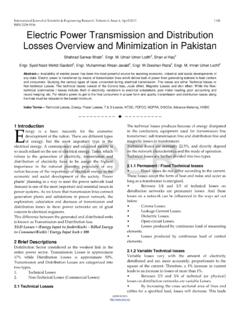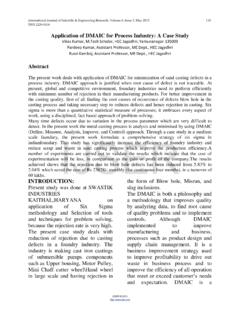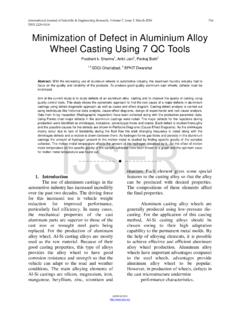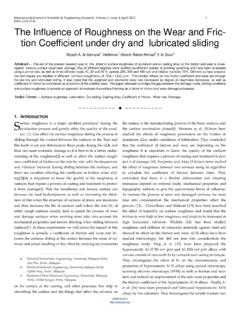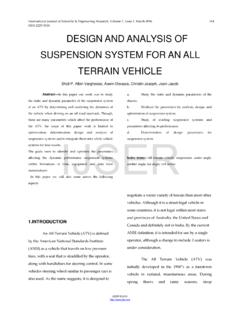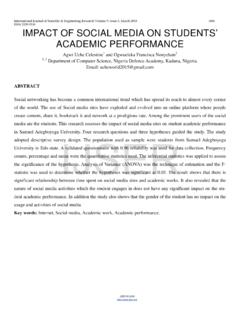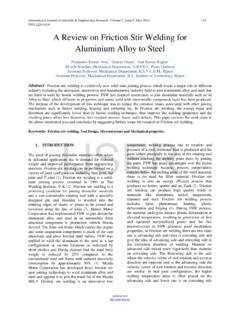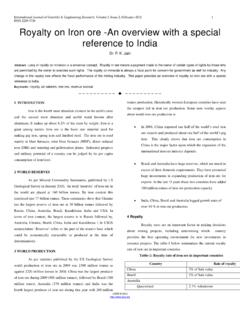Transcription of A CASE STUDY OF SUPPLY CHAIN MANAGEMENT SYSTEM - …
1 International Journal of Scientific & Engineering Research, Volume 7, Issue 5, May-2016 1698 ISSN 2229-5518 IJSER 2016 A CASE STUDY OF SUPPLY CHAIN MANAGEMENT SYSTEM Sunil Kumar Department of Mechanical Engineering Dronacharya College of Engineering Farukhnagar, Gurgaon, Haryana, India. Abstract: - Organizations increasingly find that they must rely on effective SUPPLY chains, or networks, to successfully compete in the global market and networked economy .This concept of business relationships extends beyond traditional enterprise boundaries and seeks to organize entire business processes throughout a value CHAIN of multiple companies. SUPPLY CHAIN MANAGEMENT is the term used to describe the MANAGEMENT of the flow of material ,information and fund across the entire SUPPLY CHAIN , from suppliers to component producers to final assemblers to distribution (warehouses and retailers), and ultimately to the consumer.
2 In fact, it often includes after-sales service and returns or rec yc ling. In c ontrast to multi-selection inventory MANAGEMENT , this coordinates inventories at multiple locations. Keywords: - SUPPLY CHAIN , organization, SCM, Just-In-Time, cost, suppliers, intermediaries, third-party service providers. Introduction The challenge of SUPPLY CHAIN design and MANAGEMENT is in the capability to design and assemble assets, organizations, skills, and competences. It encompasses the team, partners, products, and processes. A SUPPLY CHAIN is defined as a set of three or more entities (organizations or individuals) directly involved in the upstream and downstream flows of products, services, finances or information from a source to a customer . Organizations increasingly find that they must rely on effective SUPPLY chains, or networks, to successfully compete in the global market and networked economy.
3 This concept of business relationships extends beyond traditional enterprise boundaries and seeks to organize entire business processes throughout a value CHAIN of multiple companies. There have been few changes in business environment that have contributed to the development of SUPPLY CHAIN networks. First, as an outcome of globalization and proliferation of multi-national companies, joint ventures, strategic alliances and business partnerships were found to be significant success factors, following the earlier "Just-In-Time", "Lean MANAGEMENT " and "Agile Manufacturing" practices. Second, technological changes, particularly the dramatic fall in information communication costs, a paramount component of transaction costs, has led to changes in coordination among the members of the SUPPLY CHAIN network.
4 So SUPPLY CHAIN MANAGEMENT is the term used to describe the MANAGEMENT of the flow of material ,information and fund across the entire SUPPLY CHAIN , from suppliers to component producers to final assemblers to distribution (warehouses and retailers), and ultimately to the consumer. In fact, it often includes after-sales service and returns or recycling. In contrast to multi-selection inventory MANAGEMENT , this coordinates inventories at multiple locations. Overview of SCM The origins of the technique we now know as SUPPLY CHAIN MANAGEMENT are thought to lie in the shipyards of Japan and were first used in the early 1950s. The technique was later used in the car manufacturing industry and in particular was pioneered, again in Japan, by Toyota. Why did SCM start? In order that manufacturing companies could increase their competitiveness and thus their market share and profitability by: Minimizing the costs of production on a continuing basis.
5 Introducing new technologies. Improving quality, and being able to concentrate on what they do best. This could not be achieved with traditional supplier relationships because of the Following factors; Costs Bids based on designs to which suppliers made no input, so may be hard and expensive to build and assemble. Low bids won so suppliers were encouraged to bid low. But low prices were unsustainable so had to increase by some other means. Assembler took no interest in the supplier Didn t understand underlying costs which may be high. Thought low price meant low cost so attacked margin. Gave short-term contract so no chance of supplier investing to reduce underlying costs. IJSERI nternational Journal of Scientific & Engineering Research, Volume 7, Issue 5, May-2016 1699 ISSN 2229-5518 IJSER 2016 Technology Margins cut to the bone ergo suppliers had no money to invest in new technologies.
6 Quality Starts with the design which may be faulty and not fit with other suppliers. Needs investment in people and systems but no money as overheads attacked. Assembler couldn t concentrate on what it did best Too busy trying to do everything The result of all this was: Functionality of finished product was compromised Cost inflation inevitable as all parties found ways to make money Profits low and made by expediency not planning Suppliers distant from final customer so took limited interest in quality There had to be a better way - it was SUPPLY CHAIN MANAGEMENT . Overview: SUPPLY CHAIN The challenge is how to expand the global logistics and distribution network, in order to ship products to customers who demand them in a dynamic and rapidly changing set of channels.
7 The term SUPPLY CHAIN consists up image of product or SUPPLY moving from supplier to manufacture to distributor to retailer to customer along a CHAIN . It also implies that only one player is involved at each stage. So a . SUPPLY CHAIN should actually be efficient and effective. In this case, efficient means to minimize resource use to accomplish specific outcomes and effective, in terms of designing distribution channels. Efficiency is measured by delivery performance, product quality, backorders and inventory level, whereas effectiveness is measured by service quality and the service needs. Long-term competitiveness therefore depends on how well the company meets customer preferred in terms of service, cost, quality, and flexibility, by designing the SUPPLY CHAIN , which will be more effective and efficient than the competitors.
8 Optimization of this equilibrium is a constant challenge for the companies which are part of SUPPLY CHAIN . To be able to optimize this equilibrium, many strategic decisions must be taken and many activities coordinated. This requires careful MANAGEMENT and design of the SUPPLY CHAIN . The SUPPLY CHAIN may include internal divisions of the company as well as external suppliers that provide input to a local company. A supplier for this company has his own set of suppliers that provide input (also called second tier suppliers). SUPPLY chains are essentially a series of linked suppliers and customers until products reach the ultimate customer. SUPPLY CHAIN MANAGEMENT SUPPLY CHAIN MANAGEMENT encompasses the planning and MANAGEMENT of all activities involved in sourcing and procurement, conversion, and all logistics MANAGEMENT activities.
9 Importantly, it also includes coordination and collaboration with channel partners, which can be suppliers, intermediaries, third-party service providers, and customers. In essence, SUPPLY CHAIN MANAGEMENT integrates the whole SYSTEM MANAGEMENT SYSTEM ; each SYSTEM is interlinked to other SUPPLY CHAIN MANAGEMENT is the combination of the enterprise strategies, business process and information technologies that integrates the suppliers of raw materials or components, the manufacturers or assemblers of the finished products, and distributors of the products or services into one cohesive process to include demand forecasting, materials requisition, order processing, order fulfillment, transportation services, receiving, invoicing, and payment processing.
10 SUPPLY CHAIN MANAGEMENT is a cross-functional approach to managing the movement of raw materials into an organization, certain aspects of the internal processing of materials into finished goods, and then the movement of finished goods out of the organization toward the end-consumer. customer are only point from which service provider get value for his product .These functions are increasingly being outsourced to other entities that can perform the activities better or more cost effectively. Customer and supplier are main focus point of SUPPLY CHAIN . Cash flow and order flow from direct customer to supplier, means SUPPLY of product depend on the order received from customer. Inventory of product requires at two point firstly when supplier SUPPLY raw material to manufacture, secondly when manufacture SUPPLY finish good to the customers as shown in.
